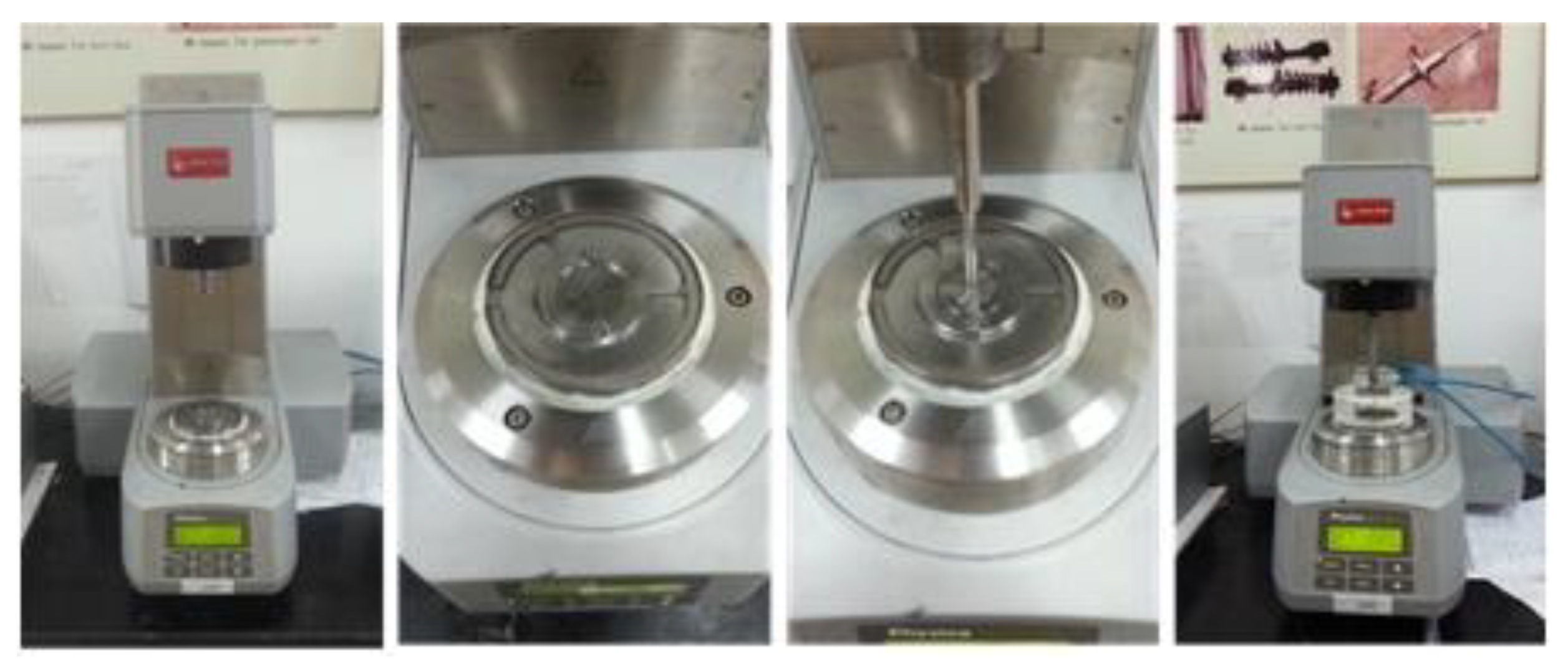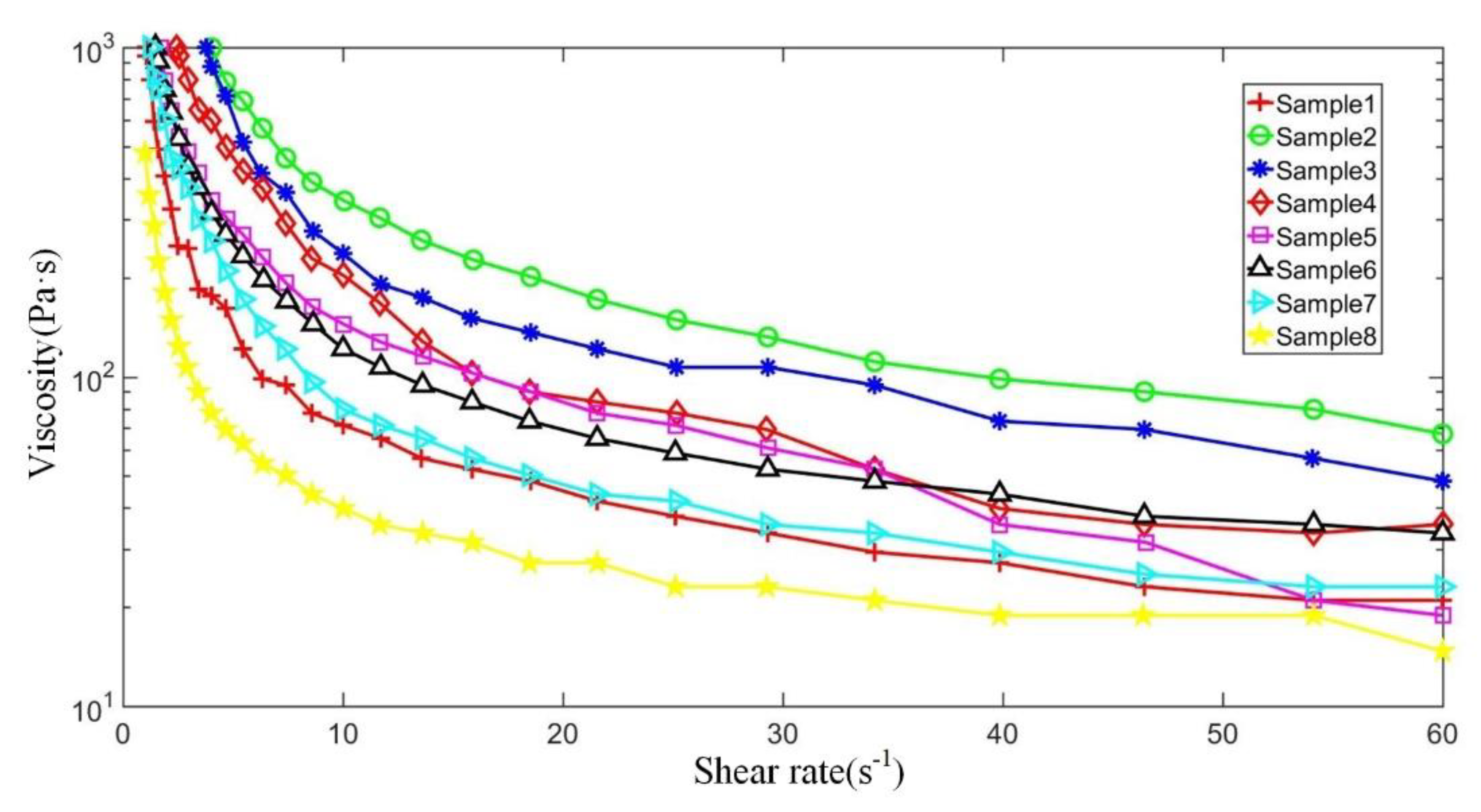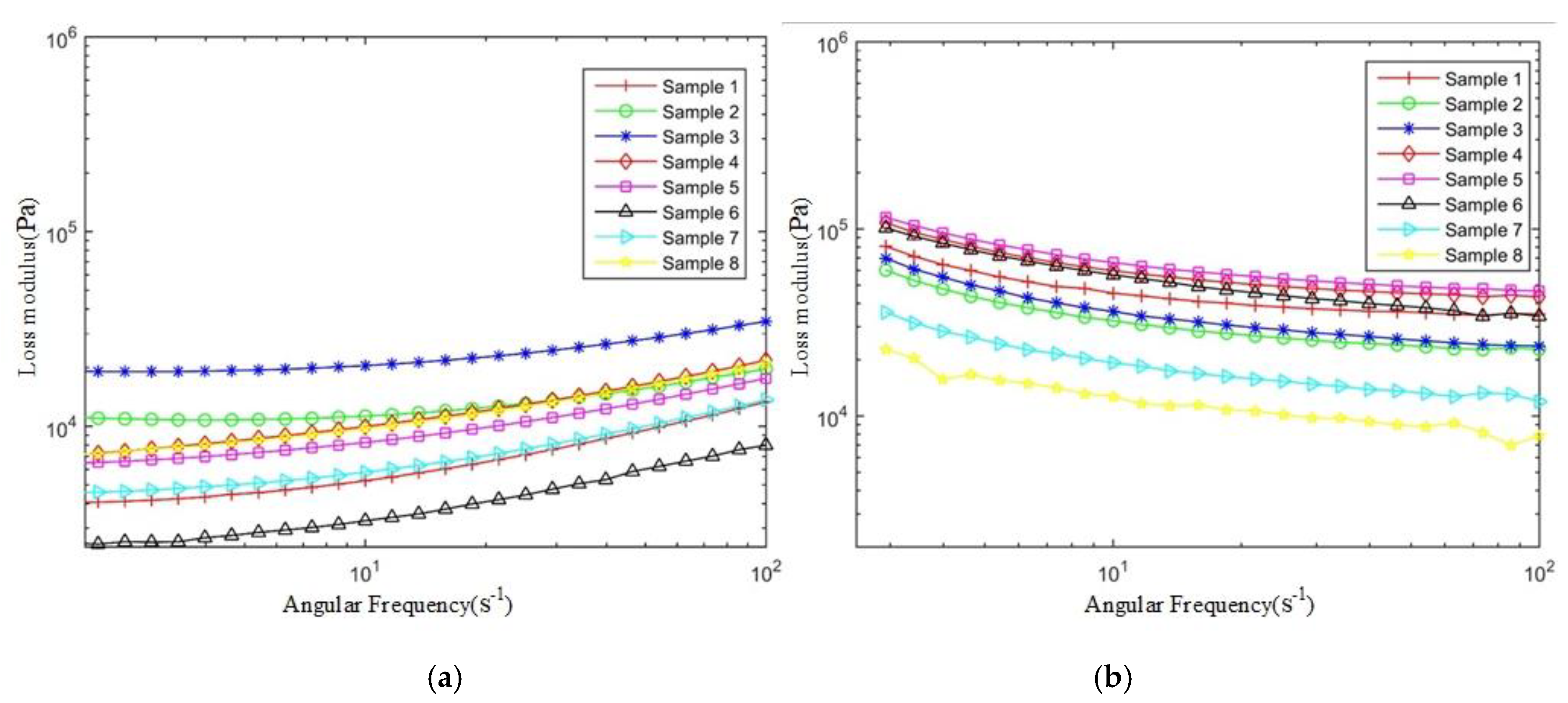Studies with Rheological Behavior of Composite Lithium-Based Magnetorheological Grease
Abstract
:1. Introduction
2. Experiments
2.1. Preparation of MR Grease
2.2. Performance Test
3. Results and Discussion
3.1. Rheological Properties
3.1.1. Analysis of Off-State Viscosity
3.1.2. Analysis of Shear Stress
3.2. Dynamic Viscoelastic Properties
3.2.1. Analysis of Storage Modulus
3.2.2. Analysis of Loss Modulus and Angular Frequency
4. Conclusions
- Under the off-state of the magnetic field, the prepared composite MR grease has typical shear thinning characteristics. At a low shear rate which is less than 40 s−1, the viscosity of composite MR grease decreases with the increase of lithium borate content.
- With the increase of the magnetic field, the increase of shear stress with prepared composite lithium-based MR grease can be divided into two regions which are the slow growth region and rapid growth region. Compared with the MR grease of a single thickener, the shear stress of the composite lithium-based MR grease is significantly improved. The maximum shear stress is increased from 54 kPa to 73.5 kPa with a magnetic field of 0.6 T.
- Comparing the MR grease with a single thickener, the shear yield stress of composite MR grease can be improved by adjusting the ratio of mass between lithium stearate and lithium borate. When the magnetic field is 0.6 T, the shear yield stress increased from 54.7 kPa to 72.6 kPa. The shear yield stress of composite MR grease with a mass ratio of 4 is increased by 166.7% with a magnetic field of 0.2 T.
- Compared with the MR grease of a single thickener, the prepared composite lithium-based MR grease has been promoted with MR effect. When the shear strain is fixed at 0.1%, the maximum MR effect reaches 23,600% which is increased by 19.1% than that of MR grease with a single thickener.
Author Contributions
Funding
Institutional Review Board Statement
Informed Consent Statement
Data Availability Statement
Conflicts of Interest
References
- Dyke, S.J.; Spencer, B.F.; Sain, M.K.; Carlson, J.D. Modeling and control of magnetorheological dampers for seismic response reduction. Smart Mater. Struct. 1996, 5, 565–575. [Google Scholar] [CrossRef]
- Choi, S.B.; Hong, S.R.; Sung, K.G.; Sohn, J.W. Optimal control of structural vibrations using a mixed-mode magnetorheological fluid mount. Int. J. Mech. Sci. 2008, 50, 559–568. [Google Scholar] [CrossRef]
- Dong, X.M. Semi-active control of magneto-rheological variable stiffness and damping seat suspension with human-body model. Int. J. Veh. Des. 2013, 63, 119–136. [Google Scholar] [CrossRef]
- Nguyen, S.D.; Choi, S.B.; Nguyen, Q.H. A new fuzzy-disturbance observer-enhanced sliding controller for vibration control of a train-car suspension with magnetorheological dampers. Mech. Syst. Signal. Process. 2018, 105, 447–466. [Google Scholar] [CrossRef]
- Weber, F.; Distl, H. Amplitude and frequency independent cable damping of Sutong Bridge and Russky Bridge by magnetorheological dampers. Struct. Control. Health Monit. 2015, 22, 237–254. [Google Scholar] [CrossRef]
- Yang, J.; Sun, S.S.; Tian, T.F.; Li, W.H.; Du, H.P.; Alici, G.; Nakano, M. Development of a novel multi-layer MRE isolator for suppression of building vibrations under seismic events. Mech. Syst. Signal. Process. 2016, 70–71, 811–820. [Google Scholar] [CrossRef] [Green Version]
- Casciati, F.; Rodellar, J.; Yildirim, U. Active and semi-active control of structures—Theory and applications: A review of recent advances. J. Intell. Mater. Syst. Struct. 2012, 23, 1181–1195. [Google Scholar] [CrossRef]
- Díaz. Tena, E.; Marcaide, L.; Góme, F.J.; Chaires Bocanegra, D.L. Use of Magnetorheological Fluids for Vibration Reduction on the Milling of Thin Floor Parts. Procedia Eng. 2013, 63, 835–842. [Google Scholar] [CrossRef] [Green Version]
- Urreta, H.; Aguirre, G.; Kuzhir, P.; Lacalle, L.D. Seals Based on Magnetic Fluids for High Precision Spindles of Machine Tools. Int. J. Precis. Eng. Manuf. 2018, 19, 495–503. [Google Scholar] [CrossRef] [Green Version]
- Urreta, H.; Aguirre, G.; Kuzhir, P.; Lacalle, L.D. Actively lubricated hybrid journal bearings based on magnetic fluids for high-precision spindles of machine tools. J. Intell. Mater. Syst. Struct. 2019, 30, 2257–2271. [Google Scholar] [CrossRef] [Green Version]
- Puma-Araujo, S.D.; Olvera-Trejo, D.; Martínez-Romero, O.; Urbikain, G.; Elías-Zúñiga, A.; Lacalle, L.N. Semi-Active Magnetorheological Damper Device for Chatter Mitigation during Milling of Thin-Floor Components. Appl. Sci. 2020, 10, 5313. [Google Scholar] [CrossRef]
- Park, B.O.; Park, B.J.; Hato, M.J.; Choi, H.J. Soft magnetic carbonyl iron microsphere dispersed in grease and its rheological characteristics under magnetic field. Collid Polym. Sci. 2011, 289, 381–386. [Google Scholar] [CrossRef]
- Kintz, A.K.; Carlson, D.J.; Munoz, B.C.; Sessoms, J.D. Magnetorheological grease composition. USP 2003, 6547986, B1. [Google Scholar]
- Wang, H.; Zhang, G.; Wang, J. Quasi-Static Rheological Properties of Lithium-Based Magnetorheological Grease under Large Deformation. Material 2019, 15, 2431. [Google Scholar] [CrossRef] [PubMed] [Green Version]
- Sahin, H.; Gordaninejad, F.; Wang, X.; Fuchs, A. Rheological behavior of magnetorheological grease (MRG). Proceeding SPIE Act. Passiv. Smart Struct. Integr. Syst. 2007, 6525, 1–9. [Google Scholar]
- Sahin, H.; Wang, X.; Gordaninejad, F. A New Model for Yield Stress of Magnetorheological Greases/Gels under Combined Effects of Magnetic Field and Temperature. Proceeding SPIE Act. Passiv. Smart Struct. Integr. Syst. 2009, 7288, 1–9. [Google Scholar]
- Kim, J.E.; Ko, J.D.; Liu, Y.D.; Kim, I.G.; Choi, H.J. Effect of Medium Oil on Magnetorheology of Soft Carbonyl Iron Particles. Magn. IEEE Trans. Magn. Mag. 2012, 48, 3442–3445. [Google Scholar] [CrossRef]
- Mohamad, N.; Ubaidillah; Mazlan, S.A.; Ubaidillah; Choi, S.B.; Aziz, S.A.A.; Sugimoto, M. The Effect of Particle Shapes on the Field-Dependent Rheological Properties of Magnetorheological Greases. Materials 2019, 20, 1525. [Google Scholar]
- Wang, K.J.; Dong, X.M.; Li, J.L.; Shi, K.Y.; Li, K.J. Effects of Silicone Oil Viscosity and Carbonyl Iron Particle Weight Fraction and Size on Yield Stress for Magnetorheological Grease Based on a New Preparation Technique. Materials. 2019, 12, 1778. [Google Scholar] [CrossRef] [Green Version]
- Prasad, M.H.; Gangadharan, K.V. Synthesis and Magneto Mechanical Properties of MR Grease. Int. J. Eng. Res. Technol. 2014, 3, 2369–2372. [Google Scholar]
- Park, J.H.; Kwon, M.H.; Park, O.O. Rheological Properties and Stability of Magnetorheological Fluids using Viscoelastic Medium and Nanoadditives. Korean J. Chem. Eng. 2001, 18, 580–585. [Google Scholar] [CrossRef]
- Hu, Z.D.; Yan, H.; Wang, X.M.; Yang, J.J.; Guo, J.J. The effect of soap content on the rheology of mineral oil-based magnetorheological grease. J. Funct. Mater. 2015, 2, 02105–02108. [Google Scholar]
- Wang, K.J.; Dong, X.M.; Li, J.L.; Shi, K.Y. Yield dimensionless magnetic effect and shear thinning for magnetorheological grease. Results Phys. 2020, 18, 103328. [Google Scholar] [CrossRef]
- Mohamad, N.; Ubaidillah; Mazlan, S.A.; Imaduddn, F.; Choi, S.B.; Yazid, I. A comparative work on the magnetic field-dependent properties of plate-like and spherical iron particle-based magnetorheological grease. PLoS ONE 2018, 13, 0191795. [Google Scholar] [CrossRef] [Green Version]
- Yao, L.D.; Yang, H.N.; Sun, H.W.; Duan, Q.H. Research of Rheology for the Lithium Grease. Acta Pet. Sin. 2011, 1001–8719. [Google Scholar]
- Zeng, H.; Chen, X.N.; Chen, Z.; Ji, H.B. Influence of Composition of Complex Lithium-based Lubricant Grease on the Microstructure. Lubr. Eng. 2011, 36, 42–47. [Google Scholar]
- Yan, M.; Meng, K.; Wu, J.; Zhou, Y.; Yang, W. Rheological property of composite lithium based magnetorheological grease based on poly-alapha olefin synthetic base oil. Mater. Mech. Eng. 2021, 45, 20–24. [Google Scholar]
- Mohamad, N.; Mazlan, S.A.; Ubaidillah; Choi, S.B.; Nordin, M.F.M. The Field-Dependent Rheological Properties of Magnetorheological Grease Based on Carbonyl-Iron-ParticleS. Smart Mater. Struct. 2016, 25, 10. [Google Scholar] [CrossRef]
- Nasir, N.; Nazmi, N.; Mohamad, N.; Ubaidillah, U.; Nordin, N.A.; Mazlan, S.A.; Aziz, S.; Shabdin, M.; Yunus, N. Rheological Performance of Magnetorheological Grease with Embedded Graphite Additives. Materials 2021, 14, 5091. [Google Scholar] [CrossRef] [PubMed]
- Bao, W.; Dario, C.; Chen, J.B. Delay of re-entanglement kinetics by shear-induced nucleation precursors in isotactic polypropylene melt–ScienceDirect. Polymer 2020, 210, 123000. [Google Scholar]
- Castillo-Tejas, J.; Castrejón-González, O.E.; Carro, S.; Gonzalez-Coronel, V.; Alvarado, J.; Manero, O. Associative polymers. Part III: Shear rheology from molecular dynamics. Colloids Surf. A Physicochem. Eng. Asp. 2016, 491, 37–49. [Google Scholar] [CrossRef]
- Zhu, T.B. Encyclopedia of grease technology. China Petrochem. Press. 2004, 479–480. [Google Scholar]
- Yang, G.; Zheng, T.; Cheng, Q.H.; Zhang, H.C. Molecular dynamics simulation on shear thinning characteristics of non-Newtonian fluids. Acta Phys. Sin. 2021, 70, 124701. [Google Scholar]
- Dai, J.; Chang, H.; Zhao, R.; Huang, J.; Li, K.Q.; Xie, S.P. Investigation of the relationship among the microstructure, rheological properties of MR grease and the speed reduction performance of a rotary micro-brake. Mech. Syst. Signal. Process. 2019, 116, 741–750. [Google Scholar] [CrossRef]








| Materials | Mass(g) | |||||||
|---|---|---|---|---|---|---|---|---|
| Sample 1 | Sample 2 | Sample 3 | Sample 4 | Sample 5 | Sample 6 | Sample 7 | Sample 8 | |
| Carbonyl iron | 90 | |||||||
| Silicone oil | 30 | |||||||
| Diphenylamine | 0.1 | |||||||
| Lithium thickener | 4.5 | 4.05 | 3.6 | 3.15 | 2.65 | 1.8 | 0.9 | 0 |
| Lithium stearate/lithium borate (mass ratio) | 10:0 | 9:1 | 8:2 | 7:3 | 6:4 | 4:6 | 2:8 | 0:10 |
| Sample | Magnetic Flux Density (T) | Yield Shear Stress τy (kPa) | Consistency Coefficient k | Flow Behavior Index n |
|---|---|---|---|---|
| Sample 1 | 0.2 | 5.047 | 0.4343 | 0.474 |
| 0.4 | 24.36 | 0.1572 | 0.9003 | |
| 0.6 | 43.04 | 0.1925 | 0.9112 | |
| Sample 3 | 0.2 | 18.94 | 0.3859 | 0.8378 |
| 0.4 | 37.34 | 0.3219 | 0.7211 | |
| 0.6 | 61.69 | 0.2637 | 0.8385 |
| Sample | 1 | 2 | 3 | 4 | 5 | 6 | 7 | 8 |
|---|---|---|---|---|---|---|---|---|
| Magnetorheological effect(%) | 19,800 | 3800 | 8400 | 13,600 | 23,600 | 8600 | 13,400 | 18,200 |
Publisher’s Note: MDPI stays neutral with regard to jurisdictional claims in published maps and institutional affiliations. |
© 2021 by the authors. Licensee MDPI, Basel, Switzerland. This article is an open access article distributed under the terms and conditions of the Creative Commons Attribution (CC BY) license (https://creativecommons.org/licenses/by/4.0/).
Share and Cite
Yan, H.; Li, P.; Duan, C.; Dong, X. Studies with Rheological Behavior of Composite Lithium-Based Magnetorheological Grease. Metals 2021, 11, 1826. https://doi.org/10.3390/met11111826
Yan H, Li P, Duan C, Dong X. Studies with Rheological Behavior of Composite Lithium-Based Magnetorheological Grease. Metals. 2021; 11(11):1826. https://doi.org/10.3390/met11111826
Chicago/Turabian StyleYan, Hua, Pingyang Li, Chi Duan, and Xiaomin Dong. 2021. "Studies with Rheological Behavior of Composite Lithium-Based Magnetorheological Grease" Metals 11, no. 11: 1826. https://doi.org/10.3390/met11111826
APA StyleYan, H., Li, P., Duan, C., & Dong, X. (2021). Studies with Rheological Behavior of Composite Lithium-Based Magnetorheological Grease. Metals, 11(11), 1826. https://doi.org/10.3390/met11111826






